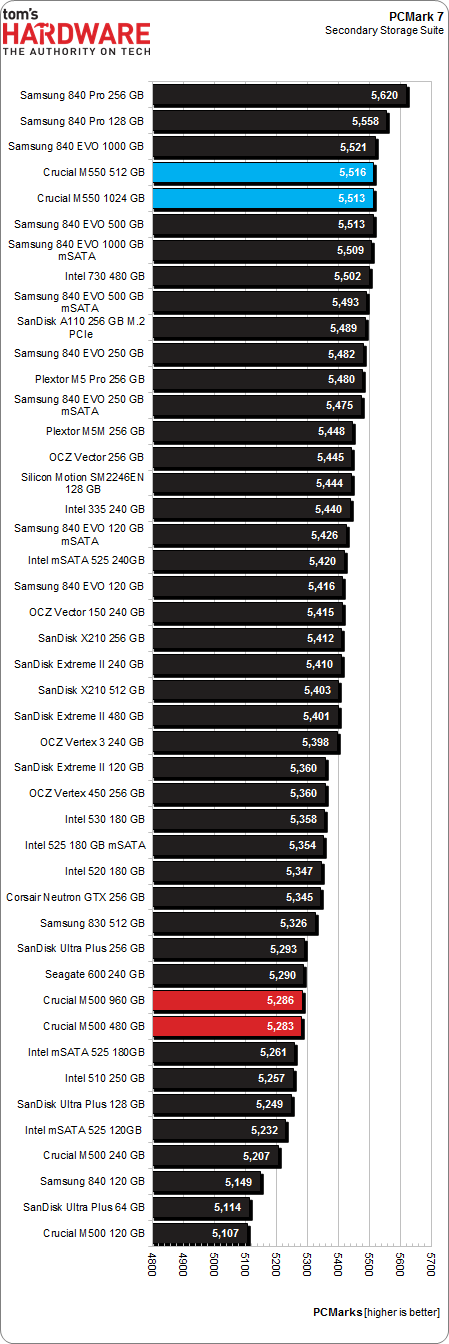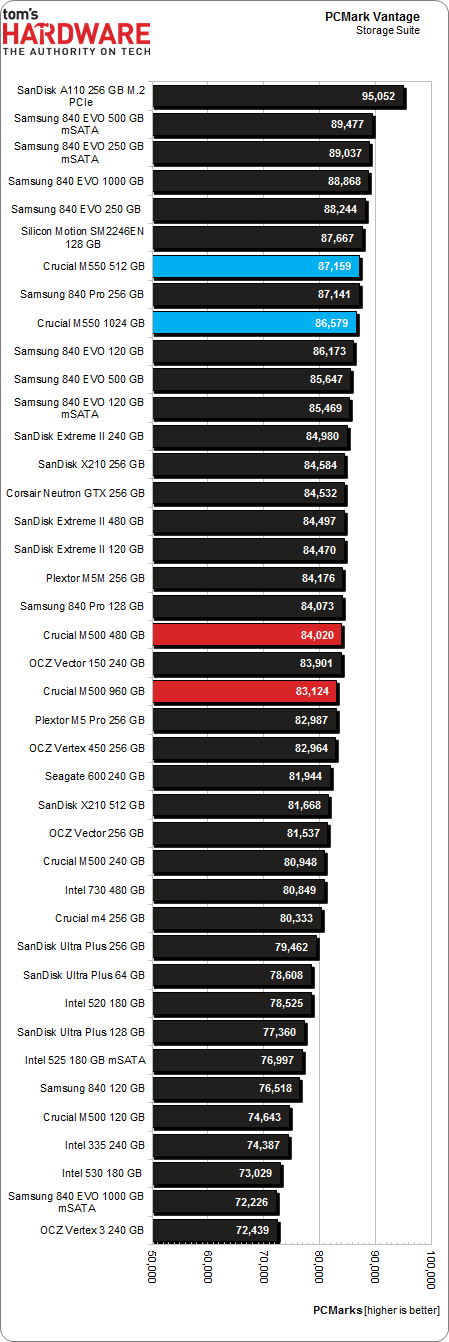The Crucial M550 SSD Review: Striking Back With More Performance
Crucial's M500 brought mainstream performance, enhanced features, and rock-bottom pricing together in one of the most-recommended SSDs of 2013. Following up, Crucial has a refined version called the M550, juiced-up for performance-hungry enthusiasts.
Results: PCMark 7 And PCMark Vantage
Futuremark's PCMark 7: Secondary Storage Suite
PCMark 7 uses the same trace-based technology as our Storage Bench v1.0 for its storage suite testing. It employs a geometric mean scoring system to generate a composite, so we end up with PCMarks instead of a megabytes per second. One-thousand points separate the top and bottom, but that encompasses a far larger difference than the score alone indicates.
This test is a big improvement over the older PCMark Vantage, at least for SSD benchmarking. The storage suite is comprised of several small traces. At the end, the geometric mean of those scores is scaled with a number representing the test system's speed. The scores generated are much different from PCMark Vantage, and many manufacturers are predisposed to dislike it for that reason. It's hard to figure out how PCMark 7 "works" because it uses a sliding scale to generate scores. Still, it represents one of the best canned benchmarks for storage, and if nothing else, it helps reinforce the idea that the differences in modern SSD performance don't necessarily amount to a better user experience in average consumer workloads.
There's no doubt that the M550 is substantially faster than the M500s. An updated controller and optimized firmware combine to land Crucial's latest at the top of this chart.
Of course, we also know that vendors like tuning their drives to show well in PCMark 7. The performance we're seeing is consistent with the rest of our testing, though.
Futuremark's PCMark Vantage: Hard Drive Suite
PCMark's Vantage isn't the paragon of SSD testing, mainly because it's old and wasn't designed for the massive performance solid-state technology enables. Intended to exploit the new features in Windows Vista, Vantage was at the forefront of consumer storage benching back in the day. Vantage works by taking the geometric mean of composite storage scores and then scaling them a lot like PCMark 7 does. But in Vantage's case, this scaling is achieved by arbitrarily multiplying the geometric sub-score mean by 214.65. That scaling factor is supposed to represent an average test system of the day (a system that's now close to a decade behind the times). PCMark 7 improves on this by creating a unique system-dependent scaling factor and newer trace technology.
Why bother including this metric, then? A lot of folks prefer Vantage in spite of or because of the cartoonish scores and widespread adoption. That, and the fact that most every manufacturer uses the aged benchmark in box specs and reviewer-specific guidelines. In fairness, Vantage's Hard Drive suite wasn't designed with SSDs in mind, and is actually quite good as pointing out which 5400 RPM mechanical disk might be preferable.
Get Tom's Hardware's best news and in-depth reviews, straight to your inbox.
Vantage is similarly kind to the M550's handful of improvements. Unfortunately, this benchmark is only tangentially relevant as a canned test, and I only have it in here because vendors continue marketing its results. We have a full set of data generated with PCMark 8 ready to go; we're just working on the best way to display it all.
Current page: Results: PCMark 7 And PCMark Vantage
Prev Page Results: Tom's Storage Bench v 1.0, Continued Next Page Results: TRIM Testing
